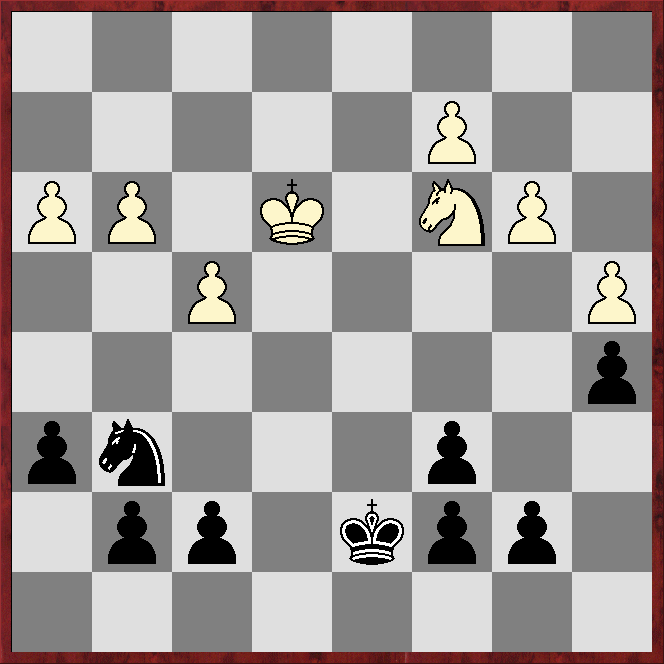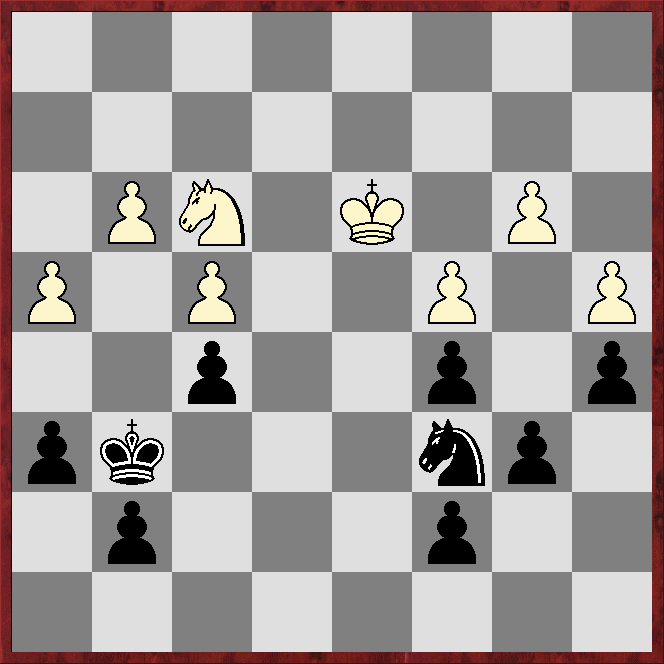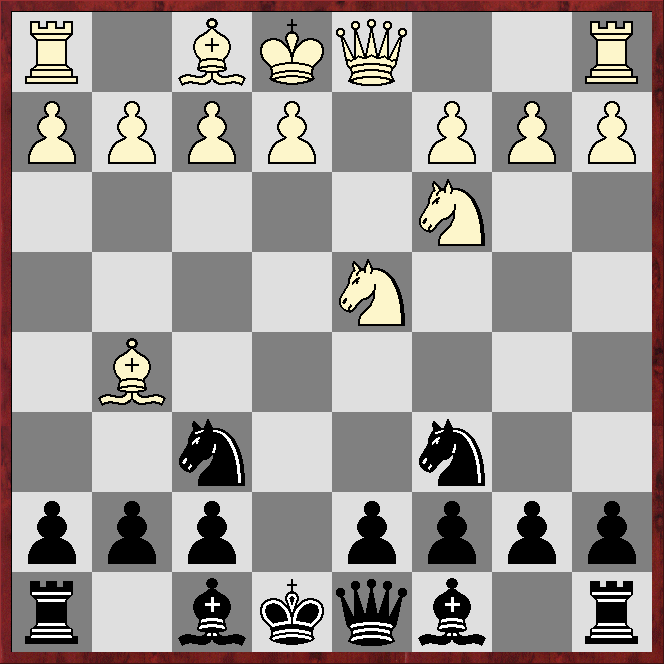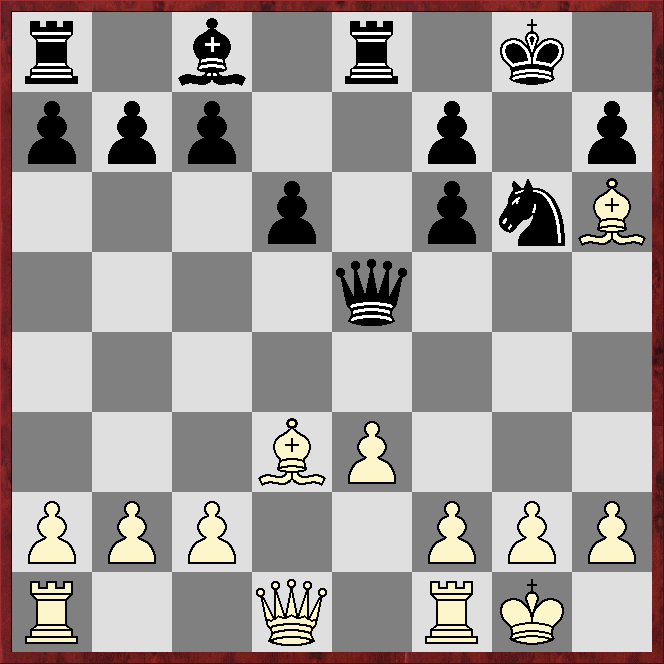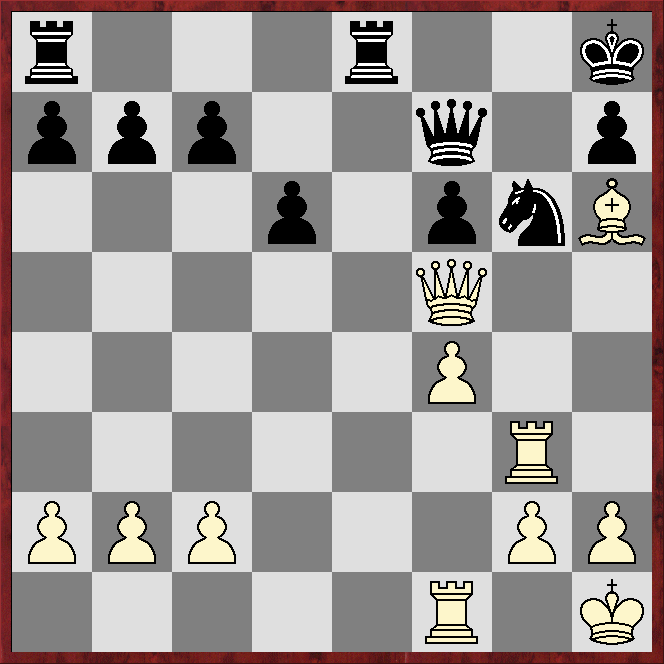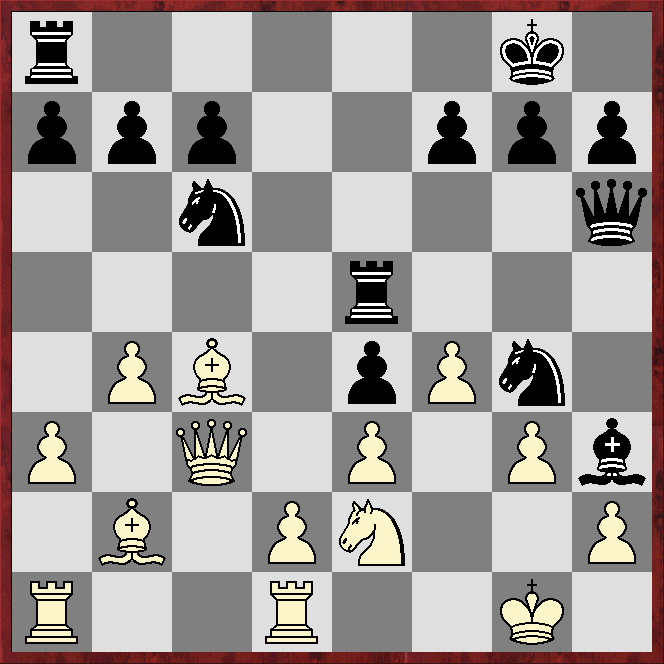 |
| Sculpture-festival entry |
Spanton (1852) - Jiří Macoun (1675)
French Rubinstein
1.Nc3 d5 2.d4 e6 3.e4 dxe4 4.Nxe4 Nf6!?
This continuation does not have a great theoretical reputation. There are 5,043 examples of the move in ChessBase's 2022 Mega database, compared with 10,385 for 4...Bd7 and 19,573 for 4...Nd7. White scores an excellent 61% after the latter two moves, but an even more impressive 67% after the text. Looking in Mega22, the oldest game with 4...Nf6!? is from 1861. Another 29 years were to pass before Adolf Albin played 4...Nd7, and a further 12 years before José Capablanca introduced 4...Bd7. But 4...Nf6!? is a favourite with some grandmasters, including Hungarian Candidate Richárd Rapport.
5.Nxf6 Qxf6 6.Nf3 h6 7.Bd3 Nc6
Rather than attacking the white centre with ...c5, Black aims for ...e5.
8.0-0 Bd6
The double-blunder 8...Nxd4?? 9.Nxd4 Qxd4?? 10.Bb5+ does not appear in Mega22, but has probably occurred in many friendly games.
9.c3
 |
| Is ...e5 already possible? |
*****
*****
*****
*****
*****
9...0-0
The game Marek Ihnát (2066) - Gyula Pap (2535), Piešťany (Slovakia) 2021, went 9...e5!? 10.dxe5 Nxe5 11.Nxe5, at which point the game was agreed drawn. Stockfish15 and Komodo13.02 continue 11...Bxe5 12.f4 Bd6 13.Re1+, claiming White has the upper hand. They reckon Black improves with 10...Bxe5!?, when 11.Nxe5 Nxe5 effectively rules out 12.f4 (12...Nxd3), while 12.Re1 is simply met by 12...0-0, after which White has the bishop-pair but must spend a tempo moving the light-square bishop to preserve it, meaning Black has equalised, according to Stockfish15, although Komodo13.02 gives White a slight edge. So the answer seems to be that 9...e5!? is playable.
10.Re1
This allows 10...e5. The main move in Mega22 is 10.Qe2, the idea perhaps being that 10...e5!? can be met by 11.Qe4. However Black can then reply 11...g6!? as the 'obvious' 12.Bxh6?! is hit by 12...Bf5 13.Qe3 exd4 14.cxd4 Rfe8 15.Qd2 Bg4, when the engines reckon Black has good compensation for a pawn. An improvement in this line for White, according to the engines, is 12.dxe5 Nxe5 13.Nxe5 Bxe5, when 14.Re1 may give White a slight edge. Rather than 10.Qe2, Stockfish15 suggests 10.Bc2!?, preparing a bishop-queen battery on the b1-h7 diagonal. Komodo13.02 prefers 10.Be4!?, but either way both engines reckon White is better.
10...Bd7?!
Missing the chance to play the thematic 10...e5, when 11.dxe5 Nxe5 12.Nxe5 Bxe5 is equal according to Stockfish15, although Komodo13.02 gives White a tiny edge.
11.Bc2
Preparing a battery on the key diagonal. Gilberto Hernández Guerrero (2510) - Luís Galego (2435), Capablanca Memorial Premier, Matanzas (Cuba) 1995, saw another way of threatening this, ie 11.Qe2. The game continued 11...Ne7 12.Ne5 (12.Qe4 Qg6 13.Qxg6 Nxg6 14.Bxg6 slightly favours White, according to the engines) Bxe5, when the engines reckon 13.dxe5 gives White the upper hand. The game saw 13.Qxe5 Qxe5 14.dxe5, when the bishops give White an edge but the game was quickly drawn.
11...Rfe8?!
Both games in Mega22 saw 11..Ne7 12.Ne5, when the engines reckon White is much better. The engines suggest 11...Rfd8, and if 12.Qd3 then 12...Qf5, when 13.Qxf5 exf5 is only slightly better for White, according to the engines. One of the points of 11...Rfd8 is to protect the light-square bishop while also vacating the f8 square for the black king.
 |
| White to play and get a winning advantage |
*****
*****
*****
*****
*****
12.Qd3
The engines give 12.Ne5!?, and if 12...Rad8 then 13.Qh5, eg 13...Be7 14.Re4 Nxe5 15.dxe5 Qf5 16.Qe2 with a huge attack, or 13...Bxe5 14.dxe5 Qe7 15.Bxh6! gxh6 16.Qxh6 f5 17.exf6 Qf7 18.Re3 etc. Alternatively 12...Bxe5 13.dxe5 Nxe5 loses to 14.Qd4.
12...Ne7?
Black should settle for 12...Qf5, when 13.Qxf5 exf5 14.Bd2 gives White at best a slight edge, according to the engines.
13.Ne5
Also strong is 13.Qh7+ Kf8 14.Qh8+ Ng8 15.Ne5, reaching a position that could also be reached in the game. White can also play 15.Bh7, eg 15...g5!? 16.Qxg8+ Ke7 17.Qxg5 hxg5 18.Bg5 Qxg5 19.Nxg5, but 19...f5 leaves White's advantage less clear.
13...Bc6 14.Re3?!
Almost certainly too slow. One line given by the engines runs 14.Qh7+ Kf8 15.h3!?, intending 16.Ng4 (if 15.Ng4 then 15...Qh4 slows White's attack, although the attack still seems strong).
14...Nf5 15.Nxc6 bxc6
Not 15...Nxe3?? 16.Qh7+ Kf8 17.Qh8#.
16.Rf3 Qh4
The engines prefer 16...c5, albeit giving White the upper hand after 17.dxc5 Bxc5 18.Qe2.
17.Rh3 Qg4 18.Bd1 Qg6 19.Bh5?!
Over-chasing the black queen. White is still better after this, but the engines' 19.Ba4 wins the c6 pawn as defending it with 19...Ne7 seems even worse, eg 20.Qxg6 fxg6 21.Re3 Kf7 22.c4.
19...Qf6 20.Bf3 Ne7 21.c4?
Fatally weakening the d pawn. White remains better after 21.Be4, eg 21...e5 22.Rf3 Qe6 23.dxe5, when having the bishop-pair and better pawn-structure give White the upper hand, according to the engines.
21...Rad8!
Preventing 22.c5 and breaking the pin on the c6 pawn.
22.Qe4 c5 23.Be3?
Better is 23.Bd2, accepting that 23...cxd4 wins a pawn.
23....cxd4 24.Bd2
Black gets a central initiative after 24.Bxd4? Bxh2+ and 25...Rxd4.
24...Qf5?!
Probably too eager for exchanges.
25.Re1?!
Probably better is 25.Qxf5, when 25...exf5 dilutes Black's pawn advantage, while 25...Nxf5 allows strong counterplay, eg 26.b4 c5 27.b5.
25...Qxe4 26.Bxe4 Be5?
Black has a large advantage after 26...Rb8.
 |
| How should White proceed? |
*****
*****
*****
*****
*****
27.Ra3!?
This switch-of-play - easy for engines to see, but not for humans focussed on the kingside - wins back White's lost pawn.
27...d3 28.Rxa7
Obvious, but the engines prefer 28.b4!?
28...c5?!
Good for White is 28...Bxb2 29.Rxc7, but the engines like 28...Nc8!? 29.Ra3 Bxb2 30.Rb3 Bf6, reckoning Black may have an edge after 31.Bxd3 Rd7.
29.b3 Nc8?!
JM went to play 29...Nc6??, but just in time saw 30.Bxc6.
30.Ra8 Bd4 31.Ba5!?
The engines for a long time reckon this is a mistake (they change their verdict a few moves into the variation detailed below the diagram), but it seems to be as strong as it looks at first glance. The engines instead suggest 31.g4!?, which seems to be aimed against ...f5. White can also play 31.Bxd3!? as 31...Bxf2+? 32.Kxf2 Rxd3 runs into 33.Be3, when White will get three connected passed pawns on the queenside.
 |
| What should Black play? |
*****
*****
*****
*****
*****
31...d2?
This looks more threatening than it is. For a long time the engines reckon Black equalises with 31...Nd6!? 32.Rxd8 Rxd8 33.Bxd8 Nxe4, but they come to agree 34.a4!? is good for White, eg 34...Nxf2 35.Kf1 d2 36.Rb1 d1=Q+ 37.Rxd1 Nxd1 38.a5 Be5 39.a6 Bb8 40.Bb6, after which White is a knight down but the white queenside pawns give excellent compensation (winning, according to Stockfish15, although Komodo13.02 allows only the upper hand). However this may be academic as the engines reckon a major improvement in this line is 33.Bh7+!?, displacing the black king further from the queenside. Much of this is very difficult to see over the board, but it is relatively easy to see the text gets Black nowhere.
32.Rd1 Rd6
No longer giving hope is ...Nd6 as 33.Rxd8 Rxd8 34.Bxd8 (34.Bh7+!? also wins) Nxe4 35.Kf1 is a much clearer win for White than the lines in the previous note.
33.Bc7 f5 34.Bxd6 Nxd6 35.Rxe8+ Nxe8 36.Bc2 Bc3 37.Kf1 Kf7 38.Ke2 Kf6 39.Rxd2!?
Returning the exchange, the point being that after ...
39...Bxd2 40.Kxd2
.... White is a pawn up, has a 3-1 queenside majority and the better piece for dealing with rival pawn majorities.
The game finished:
40...e5 41.a3 Nd6 42.Kc3 e4 43.b4 cxb4+ 44.axb4 Ke5 45.Ba4 f4 46.c5 Nc8 47.Kc4 g5 48.Bd7 Ne7 49.b5 e3 50.fxe3 fxe3 51.Kd3 Kd5 52.c6 Kd6 53.Kxe3 Nd5+ 54.Kf3 Kc7 55.Kg4 Ne3+ 56.Kh5 Nxg2 57.Kxh6 Nh4 58.h3 Kf3 59.Kh5 Kb6 60.Kg4 Nd4 61.Kxg5 Nxb5 62.h4 1-0






